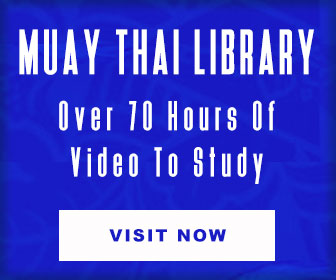As the older form of Muay Thai – the kaimuay – and its culture begins to breakdown under the wet of colonial neoisms, the bird cages hung empty – once filled with chittering birds of luck, life and karma – in one of the last sacred spaces, where hailed heroes of the ring and seeming eons of labored work on the leather of pads, where men’s voices rang out against boyhoods until everyone was made of brass balls, and they showed it in the National stadia of Rajadamnern and Lumpinee, before each was bent toward the drunken White Man, sipping or gulping on beers or various imported testerones. Here – fragmented – it still stood, in bones, in the living skeleton core, still in Arjan Surat’s heart, in the boom of his voice and the cut of his still virile, man-strong figure at the age of 74, in the very sinews of him that held like ropes and rigging against the wind-blown storm that has blown across the seas for now decades.
When we come to Dejrat, and we have come now for years, one never knows the state of the gym, a gym so fiercesome that Karuhat ran away from it, Samart seems to have dodged it even, where now National amateur teams from other nations come to prepare for tournaments, and Thai champions spend fight camps for huge sidebet fights, but…in very fragmentary fashion…Because so much of traditional kaimuay culture has been razed by the new commercial forms of the sport, and its hell-bent drive for foreigners, what holds the gym together is simply one thing – and no longer the robust, surrounding culture of decades ago – it’s Arjan Surat’s soul, and the halo of toughened men, padmen and a handful of fighters (at most) that pass through. He is a beacon, a gravitous body, an echo, a lodestone. But, one can never know how many actual people will be training, or even the work they’ll be doing. Sylvie comes on occasion, and it has been a few years, because there is nothing like that succor that comes from another time, that is actively being erased in the name of “modernization”, “globalization” and the colony.
I walk around the empty space, for the fighters are out on a run and the space is quiet like a forgotten temple, in which dusts may float in motes of light, as legends of the name sit in glass framed glories, yellowing some, and the wall mirror into which countless men of hard skin watched themselves shadow, a vertical pool of reflection. The pads and mitts are cracking. The iron weights feel rusted. There is a corner on the ring – all of this stuffed into what really is not much more than a 2 car garage adjoining Arjan’s house – on which is hung promotional and tournament ID passes, a hoard of them clustered together, Arjan’s face staring out nobly under laminates. A great deal has happened here.
Arjan comes out and smiles only lightly. He is holding his phone which might as well be a transistor radio – because at one point it really was one – on which Thai news-voice tins out in the space. I believe this is the kind of broadcast that details upcoming Thai fights for the gambler set, I’ve sat with Arjan Gimyu – a peer – who surpasses 80 now and listened to him listen to something like this, and it is carried around with Arjan Surat as he begins to sweep the gym. There is something so solitary here, Arjan Surat with his stiff broom, a ferocious trainer who scolds like an angry god made of iron, just receiving the news on a wire, kicking the settled dust out of his gym, as he has done for decades and decades, me eclipsed at the apron of the small practice ring.
The heavy bags are now only huge lumps, stacked like bodies, captive in a corner, full of their weight. When the runners return they will be hung over the mats, they rise and fall like this before and after every training session, thick-headed carnivorous blooms of leather, which eat men. I watch as Arjan gets to the edge of his mats, where they meet the drive, the gentle slope down to the culdesac where a few cars sometimes crowd and park at odd angles. These mats are not straight. He uses the end of the broom, the handle. Upside down. To tough and turn each one, fidgeting with it, precisely. So it will be as it should be.
Today there are two top Thai fighters training up for a big show, lean bodied, low-weight. One had recently lost his belt, the other coming for that belt. There’s a very sincere and perfectly intense, smart Japanese fighter who molds himself to Arjan’s demands. There is SaoEk, the twin who was banned while the other barely spared, from the stadia, a joyful energy of muay. There are hardened, toughened padmen, men of yore. A couple of other Thais. A padman who seems like he moves around to different gyms. And there is Sylvie.
The collection feels like that of refugees, each man or youth on floating pieces of shipwreck, as the sea shifts in swells and wind. And the work is so good, if only, or because it is of a few. And, there is the Captain. The man made of ropes and rigging.
Epilogue
One of the essential forms of traditional Muay Thai is fragmenting, the kaimuay…the camp, where the instructor’s gaze is only sparely distributed and the boys and men form a reflective mirror upon each other, drawn as they have been from all over the country. No longer is the gaze made like this, where the hua na measures the status of all, and the work of all reflects back upon each other, informing the careful, sculpting hand. He knows you are tired, because the others who do the same work are tired. He knows you are slacking because the others who do the same work are not tired. And the same with every spectrum and state of what you are, and what you are becoming. This organic whole, woven from culturally disparate, living threads, no longer forms very often in Thailand. The gaze is distributed quite differently, no longer a spare commodity, no longer a meaningful exchange. It is purchased by “customers” and clients, it is distributed across social networks in photos and clips. The gaze has become rampant, and with its profusion much of the entire art, the very path and form of Muay Thai’s kaimuay. The gaze carries the signal. The man of that gaze, he holds the artform in his heart and soul. Only men who walked with that gaze know it.
Media
(below photos and video from the time, if you can’t see them in subscription click through to them.)





























Monpragan fighting at Rajadamnern (in a very dubious decision fight) the next week


























